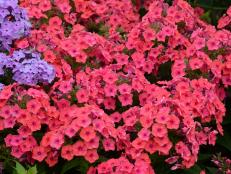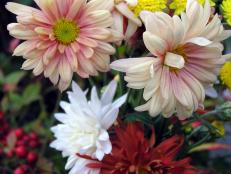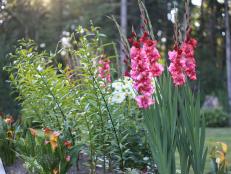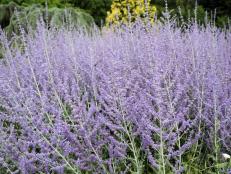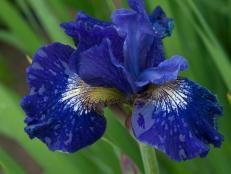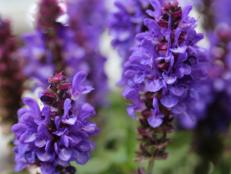How to Plant and Grow Allium
With their unusual blooms and vivid colors, ornamental alliums add an exotic touch to gardens.
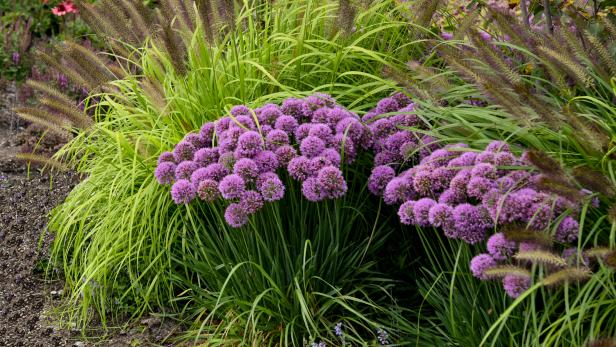
ProvenWinners.com
'Serendipity' alliums

Don't let the slight onion or garlic-y scents of their bruised leaves put you off. Alliums, or flowering onions, deserve a spot in your garden. Plant the edible allium species — onions, scallions, leeks, shallots and garlic — to use in recipes or at the table, and grow the ornamentals for their showy flowers.
There are hundreds of species in the Allium genus ("allium" is Latin for garlic). Most are perennials that grow from bulbs, but some herbaceous alliums grow from clumps of fibrous roots. These nearly carefree plants come in different heights, colors and flower forms; they resist deer, rodents and rabbits and are seldom bothered by pests or diseases. What's not to love about an allium?
Allium Basics
Botanical Name: Allium
Common Name: Flowering onion, ornamental onion, allium
Hardiness Zones: 3 to 9
Bloom Time: Late spring, summer
Bloom Color: Purple, white, silver, pink, periwinkle
Uses: Flower gardens, rock gardens, culinary gardens for edible alliums
How to Use Allium Plants
Ornamental allium species add an exotic touch to perennial beds, the backs of borders, cottage gardens and many other kinds of gardens. Their round flower clusters, called umbels, are made up of tiny florets and look like pincushions. They're held on tall, slender stems and attract butterflies and other pollinators. Ornamental alliums can be cut for fresh or dried flower arrangements.
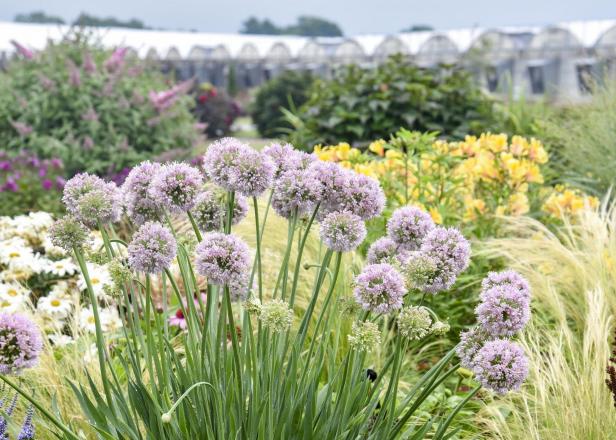
Ball Horticultural Company
'Bubble Bath' has pale lavender, bubble-shaped blooms that open from late summer to early fall. For Zones 4 to 8.
Ornamental alliums are not edible. Both ornamental and edible species, as well as derivatives made from them such as garlic powder or dehydrated onion flakes, can be toxic to cats and dogs, so keep pets safely away from them.
How to Grow Allium
Planting Allium
Plant allium bulbs in the fall after your first frost but before the ground freezes. Dig holes that are two or three times the diameter of the bulbs and space them 8 to 12 inches apart, or as directed on the tag or label.
Backfill the holes with soil mixed with organic matter and water thoroughly. Depending on the kind of alliums you're growing, they'll bloom in spring, summer or even very early fall.
Plant herbaceous alliums anytime during the growing season.
Ornamental allium foliage often appears about a month before the flowers. It may start to turn yellow and die while the flowers are still in bloom. Let it die back naturally so it can store up energy for the next season. Then the plants will go dormant until the following spring. Herbaceous alliums flower in midsummer to late summer and keep their foliage throughout the growing season.
While most ornamental allium stems are fairly sturdy, strong breezes can shatter the flowers, so plant them in a spot that gets some shelter from the wind.
Light Needs
Alliums need full sun to put on their best show. However, they can tolerate partial shade.
Soil Requirements
Slightly acidic soil with a pH of 5.5 to 6.5 is ideal, and soil that drains easily is a must. Soggy soil can make alliums rot.
How to Water
Water alliums, which are drought-tolerant, about once a week if it doesn't rain.
Fertilizer Needs
If you haven't amended your soil, apply a balanced fertilizer when the flowers start to form. Allium plants don't usually need extra fertilizer if they're growing in soil that's already been improved.
How to Prune Alliums
Alliums don't need pruning. They don't rebloom, so deadheading isn't necessary, either. You can remove the faded flowers if desired (again, let the foliage remain), or allow them to dry for late-season interest. Some alliums will self-sow from dropped, ripened seeds.
Allium Pests and Diseases
Few pests and diseases affect alliums. Avoid watering from overhead, as this can lead to fungal diseases like powdery mildew. Remove and discard — don't compost — any plants that are infected.
How to Propagate Alliums
The easiest way to propagate alliums is by division. Bulb alliums can be slow to multiply, so give them a few years to produce offsets or smaller bulbs.
Dig up the bulbs in the fall after the flowers fade, separate them and replant them right away. They may not bloom for a few years.
Allium Seeds
You can also propagate alliums from seeds you've bought or saved (although not all alliums produce seeds, and some have only a few). Be aware that if you save seeds from a hybrid, you won't get baby plants that look exactly like it.
To save seeds, let the flowerheads dry and turn brown. Then cut them off and shake them in a paper bag to catch the seeds as they fall out. Plant them in your garden right away (allium seeds need a period of cold temperatures) or store them in the refrigerator. Sow them outside for the next growing season, after your last spring frost.
Cover the seeds with 1/4-inch of soil, water gently, and keep them moist until they sprout. Some allium seeds can take months to germinate, and it may take a couple of years for allium plants grown from seeds to bloom.
Divide herbaceous alliums by digging them up when the clumps start to look crowded. Cut the fibrous roots into sections with a sharp knife and replant them.
How to Grow Alliums in Containers
Alliums don't make good houseplants. If you live where temperature extremes cause repeated cycles of freezing and thawing, you may not be successful in growing alliums in outdoor containers, either.
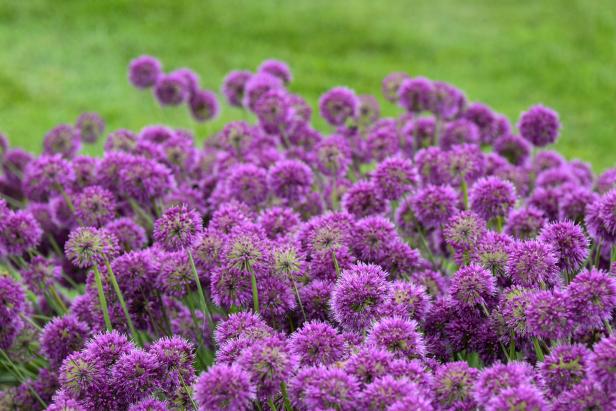
Walters Gardens, Inc.
'Lavender Bubbles' alliums have dusky-purple flowers and blue-green foliage. They bloom from late summer to early fall in Zones 4 to 8.
If your winter weather is mild, try growing alliums in a large, deep pot that won't freeze and crack in cold weather and make sure it has drainage holes. Use a good-quality potting mix that drains easily.
Types of Alliums to Grow
'Millenium' — Award-winning 'Millenium' is a hybrid with rosy-purple flowers and 15- to 20-inch stems. Hardy in Zones 4 to 8.
'Purple Sensation' (A. aflatunense) — Violet-purple globes appear in late spring on this allium, which grows to 30 inches tall. Hardy in Zones 3 to 8.
'Serendipity' — This natural variation of 'Millenium' is another flowering onion with rosy-purple flowers that appear from midsummer to late summer. The foliage has an attractive blue tinge. Hardy in Zones 4 to 8.
'Mount Everest' (A. stipitatum) — As you'd guess from its name, this allium has snow-white flowers as big as tennis balls. It matures at 36 to 40 inches tall and is hardy in Zones 4 to 9.
'Giant Globemaster' — Striking violet-purple flowers open in late spring and reach up to 10 inches in diameter. Hardy in Zones 4 to 8, this hybrid matures at 30 to 36 inches tall.
'Gladiator' — This giant allium is impressive in masses that show off its 6-inch, deep purple flowerheads. For Zones 4 to 10.
'Summer Drummer' — The 8-inch flowerheads on this fragrant allium are made up of tiny white and purple florets. The plants grow 4 to 5 feet tall with green stems that age to maroon. For Zones 4 to 9.

Ball Horticultural Company
'Summer Drummer' is a late-flowering allium. Its grapefruit-sized blooms are purple and white.
'Pink Planet' (A. scenescens) — The silvery-pink globes on this allium are just 2 to 3 inches across and open in late summer. The plants have clumps of blue-green foliage and reach 18 to 24 inches tall in Zones 4 to 9.
'Rosy Dream' (A. carolinianum) — Hardy in Zones 4 to 8, this clump-forming allium has lilac-pink flowers in late spring. It matures at 14 to 16 inches tall.
'Giant Allium' (A. giganteum) — Purple flowers that look like huge puffballs appear on these plants, also called giant onions, in spring and summer. They reach 5 feet tall in Zones 4 to 9.
'Star of Persia' (A. chistophii) — Silvery-lavender globes open to 10 inches across on this allium, which matures at 16 to 20 inches tall. For Zones 5-9.
'Drumstick' (A. sphaerocephalon) — This midsummer bloomer has egg-shaped flowers that start out green, turn pink and then darken to red-purple. It tops out at 3 feet tall. Hardy in Zones 4 to 11.
Know Your Alliums
Edible allium species are grown all over the world and used as spices, herbs and vegetables. They’ve also played an important role as medicinal plants in countries like Asia. They contain sulfuric compounds that are said to have antibacterial, anti inflammatory, antiviral and antioxidant benefits. Here’s are a few of the many species in the allium genus.
- A. cepa - Onion
- A. schoenoprasum - Chives
- A. fistulosum - Scallion or spring onion
- A. sativum - Garlic
- A. cepa, var. aggregatum - Shallot
- A. cernuum - Nodding onion
Companion Plants for Alliums
Use companion plants to hide the dying foliage of alliums or to fill in gaps left when your alliums go dormant.
- Coneflower (Echinacea)
- Hosta
- Lamb's ears (Stachys)
- Daylily
- Salvia
- Catmint
- Alchemilla
- Iris
- Peonies
- Phlox
- Lady's Mantle

.-Battle-on-the-Beach-courtesy-of-HGTV.-.jpg.rend.hgtvcom.196.196.suffix/1714761529029.jpeg)





